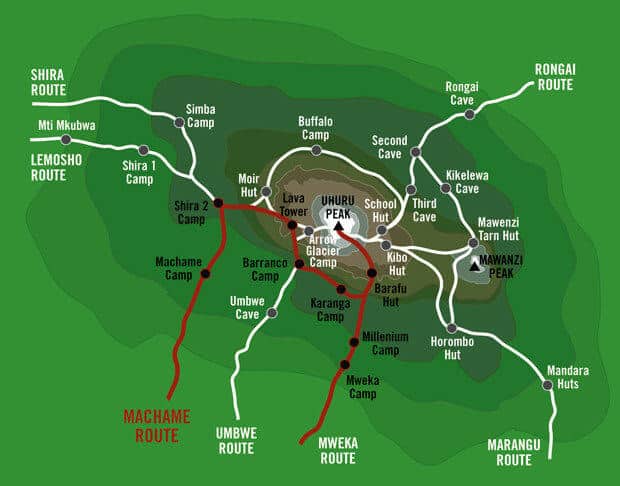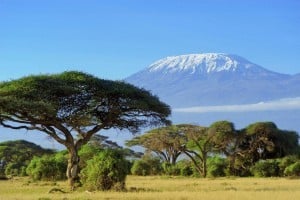Machame Route:
Day one:
To / from: Machame Gate (1500m) – Machame Camp (3000 meters).
Duration: 6 to 7 hours, 18 km.
Setting: Tropical rainforest.
Depending on your arrival, you will leave early morning and drive by car / bus to the starting point, which in this case Machame Gate Park. The climb takes you through the tropical rainforest at the foot of Mount Kilimanjaro, you will see the necessary tropical birds, monkeys including the colobus monkey and other animals, the first climb is long but easy. Overnight at the Machame Camp.
LB, AM.
Day two:
To / from: Machame Camp (3000 meters) – Shira Camp (3700 meters).
Duration: 5 to 6 hours, 9 km.
Surroundings: Moorland (lunar).
Leaving the tropical rainforest, and runs through the steppes up, over time, the steppes change into a rocky landscape, with volcanic rocks and cacti, you will see during the climb all the snow-capped peak of Mount Kilimanjaro. Overnight at Shira Camp.
O, LB, AM.
Day three:
To / from: Shira Camp (3700 meters) – Lava Tower (4630 meters) – Barranco Camp (3940 meters).
Duration: 7 hours, 15 km.
Environment: Desert.
The walk takes you past the Lava Tower, this is a rocky outcrop about a hundred meters, also known as the Shark Tooth, here you lunch. The path to the top is steep and the climb becomes heavier, normally the first symptoms of altitude sickness here noticeable. From the Lava Tower, you descend to the Barranco Camp where you spend the night. If you have opted for an extra acclimatization you can do this here.
O, LB, AM.
Day four:
From / to Barranco Camp (3940 meters) – Barafu Camp (4680 meters).
Duration: 6 to 7 hours, 13 km.
Environment: Desert, snow / ice fields.
You climb through a steep rocky path up through the Barranco wall, the views here are amazing, you pass the Karanga Valley where the last water point, save enough water here, and try at least to keep a thermos with spring water freezes at these heights the water. Arriving at the Barafu camp (Barafu is the Swahili word for ice cream), save your tents. Explore the surroundings are good because a few deep ravines are here. Make sure your bag / headlamp battery has enough power, so if you go to the toilet must not suddenly come to stand in the dark. Go at seven o’clock to bed, to get the necessary precious hours of sleep.
O, LB, AM.
Day five:
From / to Barafu Camp (4680 meters) – Uhuru Peak (5895 m, top) – Mweka Camp (2800 meters).
Duration: Barafu Camp – Uhuru Peak, 5 to 6 hours – Uhuru Peak – Mweka Camp 4 to 5 hours.
Environment: snow / ice fields, moorland.
You leave around midnight for the climb to Stella Point (5 to 6 hours), which will see an unforgettable sunrise, hereafter you climb to Uhuru Peak (1 to 2 hours) (highest peak in Africa at 5,895 meters), the trip to the top takes about six to seven hours, then you go down to Mweka Camp at 2800 meters, it takes about four to five hours. This part of the climb is by far the hardest.
O, LB, AM.
Day six:
From / to Mweka Camp (2800 meters) – Mweka Gate (1400 meters).
Duration: 3 to 4 hours.
Setting: Tropical rainforest.
You descend from Mweka Camp to Park Gate, and from here you will be returned to Moshi or Arusha, where a refreshing swim in the pool, or take a hot shower.
Oh, LB.
Included:
National Park fees, camping fees, rescue fees.
Full board camping accommodation during ascent.
English speaking guide, cook and porters.
Camping materials.
Getting to Mount Kilimanjaro, and back to Arusha.
Three meals a day
Sleeping bag and mattress
Water
Not included:
Meals and accommodation in Arusha
Personal expenses and gratuities.
Toiletries
Tips
Prices:
Six days, five nights
2 persons: 1375€ per person
3+ persons: 1325€ per person
If you have reached Stella Point or Uhuru Peak, you get at the entrance / exit a certificate with the message that you have reached the highest point in Africa.
Beware!
Climbing Mt. Kilimanjaro is often taken lightly, because we no ropes, irons or other attachments need, this does not mean that you will reach the top. Every year approximately 22 000 people start the climb to the summit of Mount Kilimanjaro only 60% gets the actual summit also (Uhuru Peak). 40% do not make it have different reasons, it may be because their condition is not good enough, or that they deal with altitude sickness get (throbbing headache, vomiting, nausea, and feeling tired and lethargic), in most cases, this time will be noticed by your guide, but unfortunately there are still too many incompetent guides, or not notice this too late.
Every year people die by incompetent guides, be sure you book with a professional and competent company.
I climbed myself Kilimanjaro, it is a fantastic ascent you the rest of your life with will continue, but beginning well organized the climb, these are a few tips that I would definitely recommend also these tips to increase your chances on reaching the summit considerably:
Train at least two months before your departure two to three times a week, you can go jogging or take long walks.
Train with a backpack of at least five kilos you carry on Mt. Kili itself a backpack that weighs about five kilograms (packed lunch, camera, binoculars, water, etc.), if you’ve never trained with this you get great muscle soreness in your shoulders.
Walk in your shoes, so do not go with brand new shoes on the mountain.
Get enough socks dry, this helps prevent blisters.
Take a high factor sunscreen, factor 25 or 30, at 3000-4000 meters altitude you naturally burn faster.
Take muesli bars and glucose along (dextro energy).
Enough warm clothes (flees).
Sufficient water purification tablets.
Norit tablets.
Good sunglasses (with UV filter).
Any tablets that help prevent altitude sickness, such as Diamox.
Headlamp or flashlight.
Garbage bags.
Rainwear.
Reading book and / or music.
Drink plenty of water during each trip.
Walk slowly and enjoy the surroundings. (too quickly climb up increases the risk of altitude sickness).




